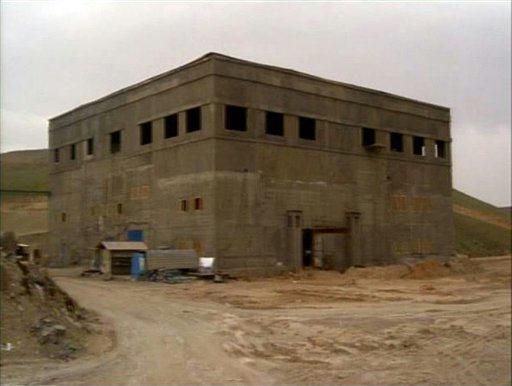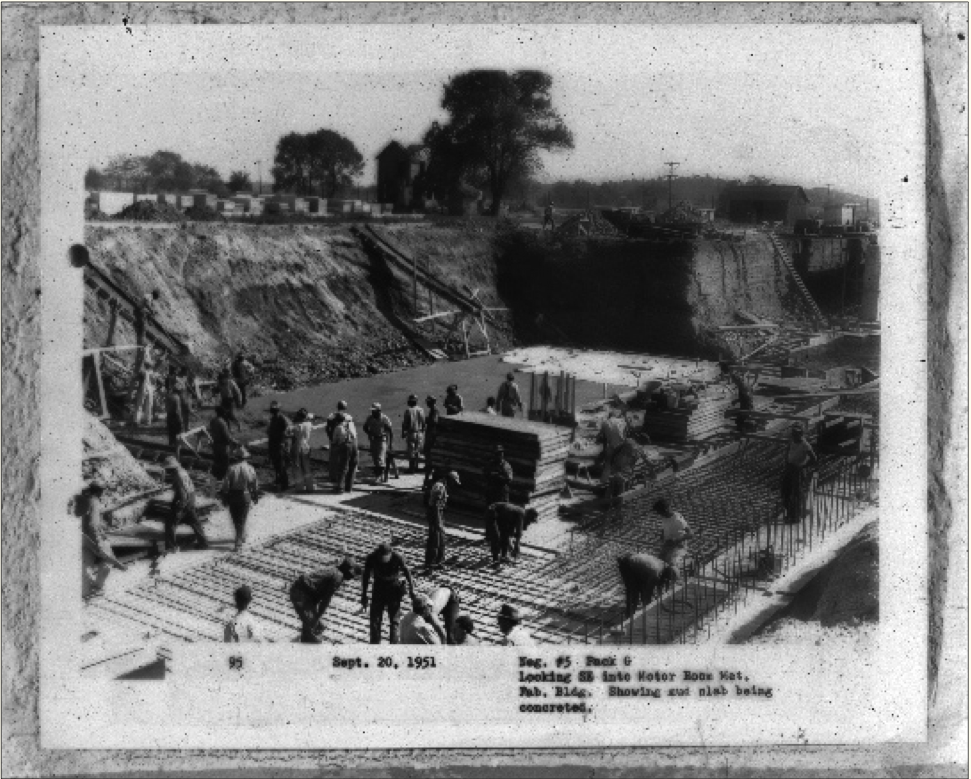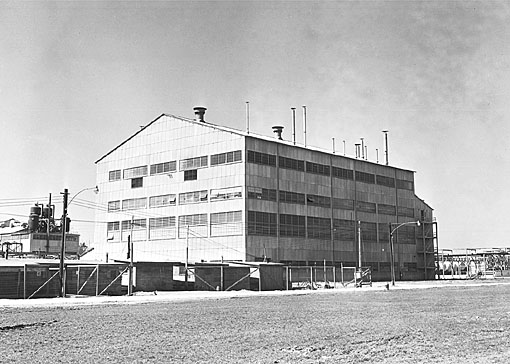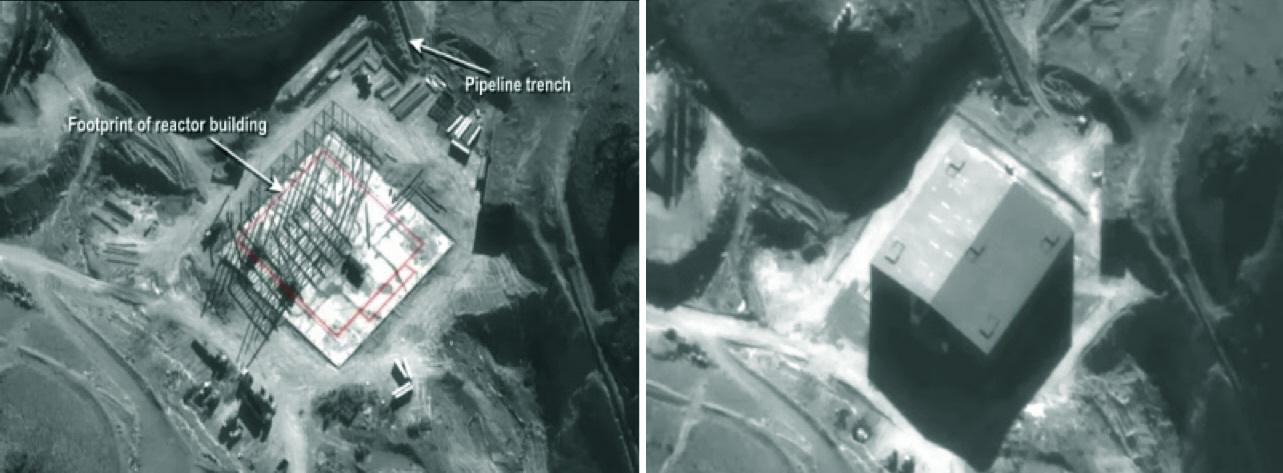Authored by JP Orient
Our times are characterized by narratives from authority that don't pass the test of logic.[1] The case of Syria's alleged "non-peaceful" nuclear reactor, destroyed by Israeli warplanes in September 2007, illustrates how technical knowledge has been diminished by argument from authority.[2] This analysis explores an alternate narrative wherein Syria's "Box on the Euphrates"[3] was a natural-uranium production facility and not a U.S.-alleged atomic reactor.
The U.S. narrative
After years of lackluster investigation and Syrian non-cooperation, inspectors reified U.S. assertions in June 2011 that Syria's Dair Alzour site was probably a nuclear reactor.[5] Their key evidence was an indeterminate number of anthropogenic uranium particles found at the site along with limited satellite imagery that was augmented by U.S.-supplied photos of undisclosed domain showing the inside of a reactor.[6] Syria was referred to the UN Security Council as a potential threat to "international peace and security."
Dair Alzour building near completion, date unknown (USG)

Syria maintains that its conventional military site was the victim of hostile attack and that an initial three particles discovered by investigators were inconsistent with the allegations. [7] Munitions or modified uranium particles planted during Israel's midnight raid explained their existence, according to Syria. Israel neither declared the alleged reactor nor its intention of destroying the site's evidence to IAEA. Damascus allowed IAEA a one-time Dair Alzour visit to collect soil, water and air samples. Syria was subsequently cited for IAEA non-cooperation after prohibiting inspectors from visiting three separate military sites on national security grounds.[8]
Sending Syria to the Security Council may have been facilitated by the factional violence and repression sweeping the country.[9] The IAEA motion, tabled by the U.S. with European support, passed by the narrowest of margins.[10] The information contained in the allegations against Syria wasn't enough to convince almost half the Board of Governors. While individuals at the vote may have sympathized with antipathy toward current events in Syria, they were disinclined to trust the narrative of authorities who had previously used false nuclear allegations to wage preemptive war.
Unlike the period preceding the 2003 Iraq war, when IAEA inspectors disproved attempts to form false narratives about aluminum tubes and Niger uranium, the Agency hasn't seriously entertained alternative explanations leading up to the bombing of Syria, excepting their dismissal of the site as unsuitable for launching missiles. Inspectors rejected the country's claims that the uranium particles were Israeli in origin as having a "low probability" of truth.[11] IAEA hasn't demonstrated the veracity of its own particle conclusions because the agency declines to reveal facts about their quantity or morphology. The Security Council referral, while mentioning Syria's risk to "international peace and security," ultimately hinged on the country's uncooperative approach to IAEA inspections rather than on whether an alleged undeclared reactor ever stood at Dair Alzour.
It was a fallacy to reject Syrian claims only because the particles didn't proscribe to depleted uranium.[12] The absence of critical thinking bypassed at least one plausible alternative that both the U.S. and Syrian authorities may have interest in concealing. One explanation that would satisfy both U.S. and Syrian assertions is Dair Alzour was built to produce armor-penetrating munitions fabricated from natural uranium.
In spite of their many differences, it can be said that Syria and the U.S. agree that Dair Alzour was a military site. Washington diplomats carefully calibrate their language by calling the facility one built for "non-peaceful" purposes. Syria says the building existed for conventional weapons. Media have adopted a haphazard language calling Dair Alzour a suspected "nuclear weapons" or "atomic bomb" facility.[13]
The tactical utility of producing natural-uranium[14] armaments would be similar to that derived from using penetrating munitions made from depleted uranium. They both pierce tank or mechanized infantry armor. The key difference is that the vast and costly nuclear industry needed to produce the uranium-238 isotope isn't required to make natural-uranium munitions. A steady supply of milled natural uranium, converted to uranium oxide and then uranium tetraflouride (also called "green salt"), mixed with magnesium and reduced through contained combustion inside a reaction vessel is all that is required to produce uranium metal.
The U.S. produced uranium metal from 1951 until 1989 at its Feed Materials Production Center outside Fernald, Ohio.[15] The plant was producing natural-uranium ingots for weapons' systems for two decades before the U.S. started to deploy its depleted-uranium stockpile in the early 1970s. [16] Uranium's density and pyrophoric characteristics allow it to penetrate and incinerate (at temperatures up to 1,800 degrees Celsius) other heavy metals.[17] Natural- or depleted-uranium munitions inevitably require another heavy-metal alloy -- titanium, molybdenum, or niobium, for example -- to counteract corrosion.
Fernald construction, September 1951 (Flour Corp.)

Although the Fernald plant never built nuclear bombs or contained a nuclear reactor, the Cincinnati Enquirer proclaimed in a four-column March 30, 1951 headline: "Hamilton County to Get Huge Atomic Plant."[18] The site's first unit was a "prototype for every phase of the uranium metal process."[19] Fernald's unit-4 was built to harvest so-called "green salt" from uranium oxide bathed in hydrochloric acid. Green salt is an intermediate compound to be further modified into enriched uranium 235 or cast as natural-uranium ingots. Fernald's unit-4 had 10 reaction beds to cast uranium metal.[20]
Fernald Unit-4, date unknown (DoE)

Dair Alzour shares physical characteristics with Fernald's unit-4 facility. Pipes connected the Syrian site to the Euphrates for cooling and discharge. Fernald was chosen for the site's "abundant water" and discharged its effluent into the Great Miami River via a buried pipeline.[21] The alleged water storage cistern near Dair Alzour's southwestern corner isn't inconsistent with the sumps and containment vessels at Fernald. Both buildings have visible ventilation ducts. Photographs show that the Dair Alzour building looks like a hardened, slightly smaller reproduction of Fernald.
Dair Alzour construction, date unknown (USG)

History, along with both Israel’s and Syria's material exigencies make the IAEA’s dismissal of alternative scenarios appear ill informed. Neither Israel nor Syria has the industrial facilities to produce depleted uranium. Both Israel and Syria would have easier routes to cast the heavy metal in its natural form. Armor-piercing munitions would have high value in any Middle East conflict.
The military-tactical advantages that uranium munitions bestow has caused alarm. China complained
Syria would be interested in concealing the nature of Dair Alzour under the alternative scenario of normal-uranium munitions production. Damascus would want to hide such a facility because it would run counter to IAEA safeguards agreements.[25] While the U.S., which has been using uranium-metal munitions since at least the 1991 Gulf War, calls the weapons conventional, its trade is restricted with competing manufactures unwanted.
Dair Alzour is a legal quagmire. Syria's Security Council referral in the absence of forensic certainty is precedent setting because it labels sovereign non-cooperation with technical experts a threat to international peace and security. The case also exposes weaknesses in the non-proliferation framework whereby states, rather than risk public approbation by declaring uranium-munitions production, may secretly dare use material for arms that nuclear-weapons states call conventional.
Ultimately, Syria's Security Council referral may have less to do with satisfying nuclear non-proliferation rules than in providing narrative cover for parties seeking to keep military-intervention options open in the region. Connections between Iran and Syria are well established.[26] Attempts to wrest Damascus from Tehran have failed, leaving the country’s future to the currents sweeping the Arab Spring
From an Israeli perspective, the Arab Spring may not appear to have yielded increased security.[28] IAEA delegates have repeatedly said that Syria's Security Council referral was intended to stand as a warning to Iran and to protect the sanctity of the safeguards regime.[29] While the referral was cloaked as necessary to protect the sanctity of law, precedence shows that war based on unproven nuclear-weapons allegations distorts the regulation of international peace.
A competent public assessment along with a release of additional data is necessary to draw a definitive conclusion about what took place at Dair Alzour. Until more facts are released and understood, a more accurate narrative explaining Israel's midnight raid and Syria's subsequent Security Council referral is this:
Syria was the canary in the coalmine. Hold your breath.
Appendix
[1] "That's not the way the world really works anymore. We're an empire now, and when we act, we create our own reality. And while you're studying that reality—judiciously, as you will—we'll act again, creating other new realities, which you can study too, and that's how things will sort out. We're history's actors ... and you, all of you, will be left to just study what we do." -- Former White House Official
[2] Form: Authority *A* believes that *P* is true. Therefore, * P* *is* true http://www.fallacyfiles.org/authorit.html
[3] http://lewis.armscontrolwonk.com/archive/1691/tourist-trips-to-the-box-o...
[4] CABLE ID: 08STATE43817, SYRIA's clandestine NUCLEAR program, 2008-04-25 01:01:00, http://213.251.145.96/cable/2008/04/08STATE43817.html
[5] http://www.aber.ac.uk/media/Documents/S4B/sem08c.html#reification
[6] Commercial satellite imagery of the site was blacked out to the IAEA and anyone else who even now seeks to purchase the pictures in the six weeks after the raid.
[7] GOV/2008/60, IAEA Implementation of the NPT Safeguards Agreement in the Syrian Arab Republic, Nov. 19, 2008, http://isis-online.org/uploads/isis-reports/documents/IAEA_Report_Syria_...
[8] Syria had reason to exercise caution. The Presidential aide dealing with IAEA's inquiries was assassinated by a sniper. http://www.reuters.com/article/2008/09/25/us-nuclear-iaea-syrianews-idUS...
[9] A Security Council resolution admonishing Syrian human rights abuses was tabled a day before the IAEA vote.
[10] The resolution passed with 17 in delegations in favor, 6 against, 11 abstaining and one state absent. http://www.iaea.org/Publications/Documents/Board/2011/gov2011-41.pdf
[11] GOV/2011/30, IAEA Implementation of the NPT Safeguards Agreement in the Syrian Arab Republic, May 24, 2011, http://www.iaea.org/Publications/Documents/Board/2011/gov2011-41.pdf
[12] Form: *p* only if *q*. Not-*q*. Therefore, not-*p*. http://www.fallacyfiles.org/ambiguit.html
[13] See http://www.timesonline.co.uk/tol/news/world/middle_east/article2983719.e... http://www.foxnews.com/opinion/2011/03/11/syria-arab-nation-develop-nucl...
[14] Normal uranium refers to the isotopic ratio whereby the heavy metal contains 0.7 percent of the uranium-235 isotope (used to produce nuclear chain reactions in atomic weapons, 99.3 percent of the uranium-238 isotope (the byproduct of uranium enrichment used in depleted uranium weapons) and trace amounts of uranium-234 isotopes.
[15] "Throughout the production years, the Fernald site’s products
[16]/a> "Evaluation of Depleted-Uranium Alloys for Use in Armor-Piercing Projectiles, June 1973, Los Alamos Scientific Laboratory, http://www.fas.org/sgp/othergov/doe/lanl/la-5238.pdf
[17] Andrews, Dr. William S., "Depleted Uranium on the Battlefield," Royal Military College of Canada, http://www.journal.dnd.ca/vo4/no1/research-recherch-eng.asp
[18] "Closing the Circle of History: a history of the Fernald Site... Its workers and successful cleanup," Fluor Corporation, The history, commissioned by the company which won the $12 billion contract to cleanup up the Fernald complex cites project manager James F. Chandler saying in 1951 that: “no weapons will be made on the site and that the production will not create environmental, toxic, radiological or explosive hazards (page 10).”
[19] Ibid (page 34)
[20] Ibid (page 76)
[21] "Alliance for Nuclear Accountability (page 28),"http://www.ananuclear.org/Portals/0/documents/Water%20Report/waterreportfernald.pdf
[22] CABLE ID 05MUSCAT679, SUBJECT: U.S.-CHINA SECURITY DIALOGUE: MEETING WITH DEPUTY CHIEF OF THE GENERAL STAFF LTGEN MA XIAOTIAN, DATE: 2005-04-25 10:10:00, CLASSIFICATION: SECRET http://www.cablegatesearch.net/cable.php?id=05MUSCAT679
[23] CABLE ID 09UNVIEVIENNA218, SUBJECT: IAEA/EGYPT: SAFEGUARDS IMPLEMENTATION REPORT CITES, DATE: 2009-05-08 15:03:00, CLASSIFICATION: SECRET http://cablesearch.org/cable/view.php?id=09UNVIEVIENNA218&hl=%22depleted... ("The IAEA then undertook a State-wide investigation of its nuclear material holdings, during which additional, previously unreported, nuclear material was identified, including several DEPLETED URANIUM items for which Egypt subsequently provided accounting reports.")
[24] CABLE ID 09UNVIEVIENNA540, SUBJECT: Staffdel Kessler Examines Iran, Syria, And Multilateral Vienna's Frustrating Nam Dynamic, DATE: Wed, 2 Dec 2009 17:17 UTC, CLASSIFICATION: SECRET http://www.cablegatesearch.net/cable.php?id=09UNVIEVIENNA540http://www.c...
[25] In constructing a uranium processing facility, Syria may have violated both the "basic undertaking" and Article 34(c) of "The Structure and Content of Agreements Between the IAEA and States Required in Connection with the Treaty on the Non-Proliferation of Nuclear Weapons. http://www.iaea.org/Publications/Documents/Infcircs/Others/infcirc153.pdf
[26] Syria and Iran
[27] CABLE ID 07DAMASCUS1193, SUBJECT: DEMOCRATIC REFORM STRATEGY SYRIA - 2007, DATE 2007-12-23 13:01:00, http://213.251.145.96/cable/2007/12/07DAMASCUS1193.html (Note: Given the current circumstances, it is noteworthy to see the U.S. engagement strategy already formulated in 2007).
http://www.cablegatesearch.net/cable.php?id=07DAMASCUS1193
[28] Hezbollah has entrenched in Lebanon
Turkey
CABLE ID 09CAIRO1957, SUBJECT EGYPT'S ECONOMY: OCTOBER 14 PRESS ROUND-UP, DATE 2009-10-14 14:02:00, http://cablesearch.org/cable/view.php?id=09CAIRO1957&hl=israel+egypt+nat...
CABLE ID 09TELAVIV2245, SUBJECT Israelis Mull Response To Turkish "humiliations", DATE Tue, 13 Oct 2009 15:58 UTC, http://www.cablegatesearch.net/cable.php?id=09TELAVIV2245
CABLE ID 09DAMASCUS390, SUBJECT: SCENESETTER FOR VISIT OF SPECIAL ENVOY MITCHELL TO DAMASCUS, DATE 2009-06-04 17:05:00, http://213.251.145.96/cable/2009/06/09DAMASCUS390.html
[29] See Mark Hibbs: http://www.carnegieendowment.org/2011/06/17/iaea-and-syria-new-paradigm-...
Theme by Danetsoft and Danang Probo Sayekti inspired by Maksimer